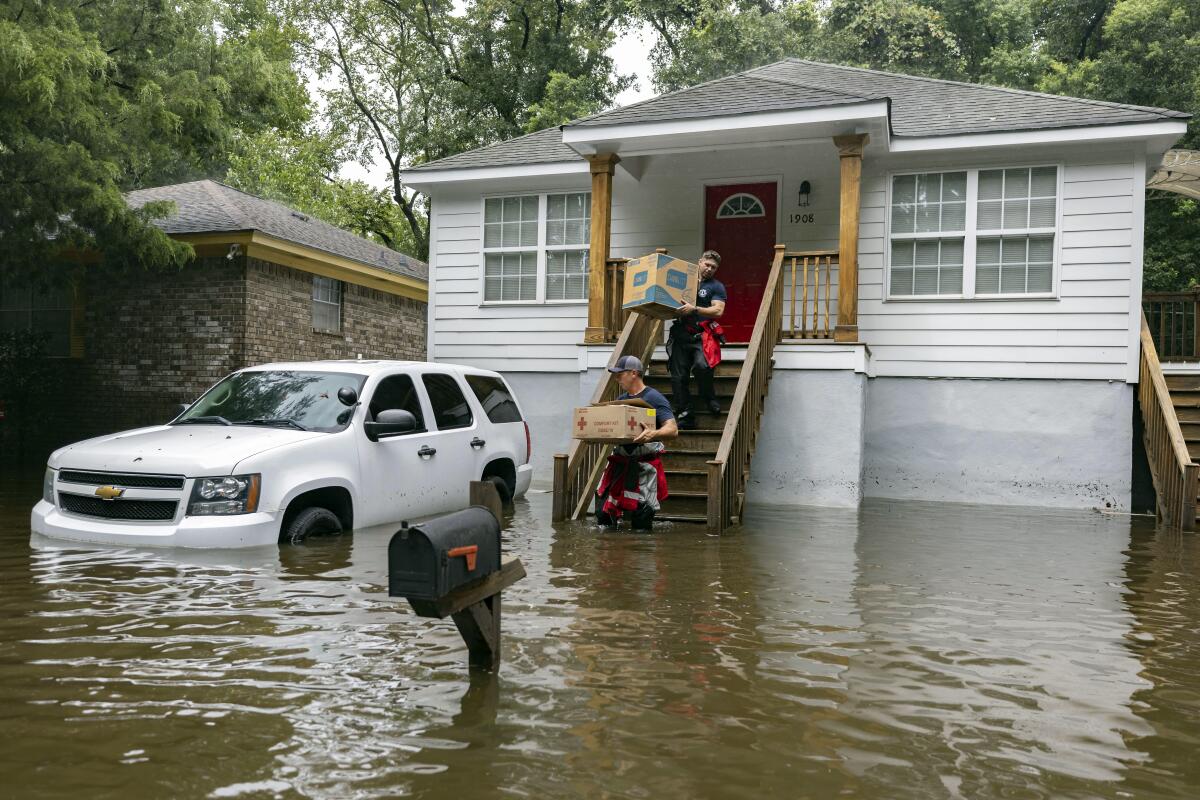Boiling Point: Heat, fires, floods — extreme weather has affected 99% of Americans

- Share via
Welcome to Boiling Point. I’m Ian James, a reporter on The Times’ climate team, writing the newsletter this week to fill in for my colleague Sammy Roth.
Extreme weather alerts for dangerous heat, wildfires, storms, flooding and other hazards have affected nearly everyone in the United States over the past few months.
Tracking data from the National Weather Service, the nonprofit Union of Concerned Scientists has found that since the beginning of May, extreme weather alerts have been issued for 99% of the country’s population.
It’s a striking statistic that underlines the growing risks the nation faces as climate change continues to intensify extremes — such as last month’s record heat in California.
My colleague Hayley Smith spoke with scientists to unpack the significance of so many extreme weather events during the period from May to October, which some researchers are now calling the “danger season.”
Her piece highlights a key point from Juan Declet-Barreto, an environmental and social scientist who analyzed the data: Many of the alerts have overlapped, meaning that millions of people have been facing multiple hazards at once, such as wildfire weather and extreme heat.

The Union of Concerned Scientists is featuring the data in a map that is updated daily while advocating for political leaders to hold the fossil fuel industry accountable.
Alex Hall, a UCLA climate scientist, said the weather alert data is one more indicator of worsening climate change impacts, and that the damages from major weather disasters, which have been dramatically increasing, are set to rise further in the years to come.
Hall said: “We have built our infrastructure for a different world, and in some ways we weren’t even that well adapted to the world that we had. And now we have a new climate.”
That comment reminded me about a new six-part podcast series I’ve been looking forward to checking out. The podcast, called “Not Built for This,” is being launched this week by the team behind “99% Invisible.”
The program says the series will explore “how climate change is laying bare the vulnerabilities in the American built environment and how communities across the country have been left to bootstrap their own survival.”
Here’s a look at more climate coverage in California and around the West.
TOP STORIES
An investigation by the Los Angeles Times and Capital & Main has found that California has sharply cut its enforcement of heat-protection laws for outdoor laborers, putting farmworkers and construction workers in danger during worsening heat waves. Investigative reporter Robert J. Lopez found that the number of state field inspections dropped by nearly 30% from 2017 to 2023, while the number of violations issued to employers fell by more than 40%. The California Division of Occupational Safety and Health, known as Cal/OSHA, says it’s creating a new agricultural unit that will “significantly expand enforcement.”
Climate change is altering conditions for desert plants, and scientists have for years projected that rising temperatures will make large portions of the Mojave Desert unsuitable for Joshua trees to survive by the end of the century. Now, scientists have found that climate change, by driving bigger swings in precipitation and warmer winters, is causing the iconic trees to flower more frequently. Alex Wigglesworth wrote about the findings for The Times and talked with biologist Jeremy Yoder about how those changes are probably reducing the survival of delicate seedlings.
Forecasters say La Niña is likely to arrive soon and remain through the winter. As my colleagues Hayley Smith and Grace Toohey report, forecasters with the National Oceanic and Atmospheric Administration say this could drive a return to drought conditions in California and the Southwest in the coming months.
POLITICAL CLIMATE
As Minnesota’s governor, Tim Walz has approved dozens of initiatives focused on clean energy and addressing climate change. In an article last week, Hayley Smith delved into Walz’s track record on climate and how he has looked to California for inspiration. His priorities in the state include slashing Minnesota’s greenhouse gas emissions in half by 2030 and achieving carbon neutrality by 2050. Lori Lodes, executive director of Climate Power, said that with Walz as Vice President Kamala Harris’ running mate, they are a ticket “who will fight for our clean energy future,” while Donald Trump and JD Vance would “give Big Oil a free pass to profiteer and pollute.”

My colleague Sammy Roth has recently written columns urging the Los Angeles Dodgers to stop taking sponsorship money from Phillips 66, owner of the 76 gas station chain. Prompted by his reporting, dozens of people and groups have since called on the team’s owner, Mark Walter, to end the deal. Roth joined the program L.A. Times Today on Spectrum News 1 to talk with Lisa McRee about why some fans want the Dodgers to break ties with the oil company. Roth noted that he has now written about the sponsorship three times, and the Dodgers have declined to respond to his requests for comments.
CALIFORNIA WILDFIRES
A bill aimed at overhauling California’s system for wildfire hazard mapping has died in the state Legislature. As Hayley Smith reports, the bill sparked heated debate over its plan to eliminate the decades-old system of ranking lands as “moderate,” “high” or “very high” fire hazard severity zones. Proponents of the legislation said the plan would streamline the current system and ensure uniform fire protection standards for all buildings in designated wildfire mitigation areas. Opponents of the bill said it would make it easier to develop more housing in fire-prone areas.
My colleague Ryan Fonseca has been speaking with fire management officials to learn more about the challenges they face. Seth Mitchell, a deputy forest fire management officer with the U.S. Forest Service based in Los Padres National Forest, told Fonseca that the conditions brought about an early start to the fire season.
Fonseca also interviewed Dan Mallia, superintendent of the Redding Hotshots, about how fire suppression over the past century has left forests loaded with excess fuels. To begin to address the problem, state and federal agencies have been embracing Indigenous practices that recognize fire as a natural force that helps balance forest ecosystems. Mallia says he is a big proponent of prescribed burns, and has seen a severe fire “slow down to almost stop” when the flames reached an area that was previously burned.
WATER IN THE WEST
The Imperial Irrigation District has approved a deal with the federal government to conserve 700,000 acre-feet of Colorado River water through 2026 by temporarily shutting off water to the fields of participating farmers. Janet Wilson reported for the Desert Sun that the irrigation district’s staff has installed locks on canal gates, which will cut off water deliveries for up to 60 days this year. In exchange, IID and farmers who volunteer to forgo water for their hay fields will be paid nearly $700 million. J.B. Hamby, vice chair of the IID board and California’s Colorado River commissioner, said the district’s efforts “provide an example for other states and regions to follow as we plan for a drier future in the Colorado River basin.”
Meanwhile, MacKenzie Elmer reports for Voice of San Diego that the San Diego County Water Authority is in discussions with IID to help farmers reach their goal by selling back some of the water San Diego purchases from the Imperial Valley.
The federal government last week announced that based on current reservoir levels on the Colorado River, Arizona, Nevada and Mexico will continue to see the same level of reductions in water deliveries next year as they did in 2024. As Suman Naishadham of the Associated Press reported, Arizona will again lose 18% of its allocation. Nevada’s reduction will stay at 7%, while Mexico has agreed to a 5% reduction.
CALLS FOR ACTION
In an opinion article in the L.A. Times, Reno pediatrician and author Debra Hendrickson shared her deep concerns about how climate change is threatening the health of children. “Because of their different physiology, small size, dependence on adults and still-developing organs, the youngest among us are uniquely vulnerable to the health threats posed by a warming world — by heat waves, wildfires, hurricanes, infectious diseases, air pollution and more.” Calling for urgent action, she wrote: “If we squander the very narrow window of time to prevent the worst, and drive emissions up instead of down, the consequences will be devastating.”
In a piece published by Yale Climate Connections, meteorologist Jeff Masters discussed intensifying extreme weather events and a likely insurance crisis in the coming years. “Although there is a major climate change hurricane approaching, we’re busy throwing a hurricane party, charging up our planetary credit card to pay for the expenses, with little regard to the approaching storm,” Masters wrote. Continuing with the hurricane analogy, he said that allowing global warming to exceed 2.5 degrees Celsius (4.5 degrees Fahrenheit) would cause “category 4-level damage to civilization — approaching the catastrophic level.”
Masters also said he is optimistic that by late this century, “we will have successfully ridden the rapids of the climate crisis, emerging into a new era of non-polluting energy with a stabilizing climate.”
“There are too many talented and dedicated people who understand the problem and are working hard on solutions for us to fail,” he said.
ONE MORE THING
For local readers in Southern California: An art exhibit starting this weekend in Los Angeles focuses on L.A.’s water challenges. Co-curator Edith de Guzman, a cooperative-extension researcher at UCLA, says the exhibit explores subjects such as local water suppliers, imported water, trust of tap water and affordability.
“I hope that people come away understanding that our relationship to and stewardship of water in L.A. is not only a critical part of our past history, but essential to determining our region’s future as well,” de Guzman said.
The exhibit also features some interactive parts, including a blind water tasting comparing bottled water brands with L.A. tap water.
The exhibit is titled “What’s on Tap: LA’s Water Story … Source to Spigot.” It opens Saturday at El Tranquilo Gallery on Olvera Street at El Pueblo Historical Monument. Through Sept. 29, it will be open Fridays through Sundays from 11 a.m. to 3 p.m.
On Sunday, an opening reception will be held at 3 p.m., followed by a screening of the classic film “Chinatown” at 5 p.m. Both are free. (See this website to register.)
An announcement for the screening says the 1974 film, starring Jack Nicholson and Faye Dunaway, still “reveals many historical aspects of LA’s water story that are stranger than fiction.”
This is the latest edition of Boiling Point, a newsletter about climate change and the environment in the American West. Sign up here to get in your inbox. Or open the newsletter in your web browser here.
For more climate and environment news, follow @Sammy_Roth and @ByIanJames on X.
Toward a more sustainable California
Get Boiling Point, our newsletter exploring climate change, energy and the environment, and become part of the conversation — and the solution.
You may occasionally receive promotional content from the Los Angeles Times.




